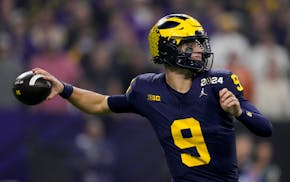FORT MYERS, FLA. - The sounds are soft and comforting as the Florida morning sun.
Joe Mauer stands in the batting cage in Hammond Stadium, waggling a Rawlings. While Justin Morneau and Michael Cuddyer try to knock fronds from the palm trees beyond fences, Mauer wields his bat like a sculptor gently chipping clay.
Mauer sends a soft grounder to short, pokes a liner to left, slaps a single to center. He might be on his way to becoming the best-hitting catcher in baseball history, yet many of his swings wouldn't break china.
"I have my routine," he said. "Actually, I learned it from Molitor."
That's obvious to anyone who watched Paul Molitor, his fellow Cretin-Derham Hall alum, take batting practice as a Twin in the '90s, when opponents would gather in the visiting dugout to see the artist at work.
Growing up in St. Paul, Mauer attended baseball clinics at Cretin-Derham Hall. One day, Molitor's friend and former high school teammate Jimmy O'Neil invited Molitor to speak to the kids.
Molitor, on his way to amassing 3,319 hits and the Hall of Fame, extolled a scientific approach to batting practice.
"I was in grade school," Mauer said. "Paul came and talked to us. I remember the one thing he talked about was how he took BP. He said he liked to spray the field. He liked to start with right field and work his way over. That's something I adopted as a kid and still do to this day."
Molitor remembers.
"Jimmy always made a point to tell me about Joe's skills at a young age," Molitor said. "I would have never imagined he would pay that much attention to instruction at that point.
"I tried to make the impression upon them about what was the most functional and productive way to take batting practice, the whole idea of trying to get your hands working, and react to where the ball is pitched.
"The batting practice pitcher is not trying to throw it by you, so you might as well see the ball as long as you can, see how many balls you can hit on the barrel of the bat.
"You hit the ball up the middle and go the other way in the early rounds, and eventually start hitting the ball where it is pitched, and at the end you feel pretty good. At that point, if you get a good pitch you might try to do some damage."
Molitor believed in "letting the ball travel" deep in the strike zone in batting practice, which helped him sharpen his batting eye and his reactions.
Mauer has adopted a similar approach, with similar results. Molitor his .306 during his career; Mauer is hitting .327.
"I want to hit line drives the other way," Mauer said. "So you have to let the ball get as deep as it can, see the ball as long as you can, especially in the early rounds of BP. Now we pretty much take batting practice that way throughout the organization.
"You hit five the other way, then you work on your skill set, and then after that, you have five pitches and you can do whatever you want with them. I usually go up the middle, and then as I get loose and get deeper into batting practice, I'll work on pulling the ball. But the key is starting with the opposite field and then moving the ball around."
While teammates swing for the fences, Mauer skips balls between short and third, honing the swing that has made him a three-time batting champ while paying homage to his roots.
"When you're 6 or 7, a lot of that stuff might fly over your head," Mauer said. "But I looked at Molitor and said, 'This guy is in the big leagues, and that's where I want to be.' So, I listened."
Jim Souhan can be heard Sundays from 10 a.m. to noon and weekdays at 2:40 p.m. on 1500ESPN. His Twitter name is Souhanstrib. • jsouhan@startribune.com

Souhan: Wolves fans made Game 1 special. Now bring on Game 2.

Souhan: Should Vikings even consider McCarthy in NFL draft?

Souhan: NAW erases Suns' lead, Game 1 advantage with big performance

Souhan: This is KAT's chance to prove Flip Saunders was right


